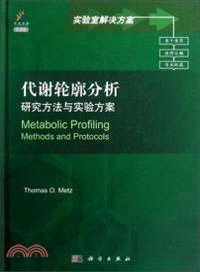代謝輪廓分析:研究方法與實驗方案(導讀版)(簡體書)
商品資訊
系列名:實驗室解決方案
ISBN13:9787030359292
出版社:科學出版社
作者:(美)托馬斯‧梅斯(Thomas O. Metz)
出版日:2013/01/01
裝訂/頁數:平裝/391頁
商品簡介
名人/編輯推薦
目次
書摘/試閱
相關商品
商品簡介
作為代謝物分析、代謝作用指紋識別和代謝組學的交叉領域,代謝譜分析經過穩步發展具備了系統的研究方法與技術。在《代謝輪廓分析:研究方法與實驗方案(導讀版)》中,經驗豐富的研究者介紹了本領域的研究方案,例證了代謝譜分析從單一分子水平的分析逐漸發展到綜合的代謝組分析。《代謝輪廓分析:研究方法與實驗方案(導讀版)》涵蓋了各種重要的研究技術,探討的主題包括先天代謝缺陷、藥物代謝分析、核磁共振代謝譜分析等。
名人/編輯推薦
在代謝物分析、代謝指紋分析和代謝組學分析的交織中,代謝輪廓分析隨著其領域內采用方法和技術的進步而穩步發展,在《代謝輪廓分析:研究方法與實驗方案》一書中,業內專家學者提供了諸多分析方案以直觀展示從單個化合物分子輪廓分析到整體代謝組輪廓分析的進步。綜合了現行基本技術手段,本書涵蓋了從先天性代謝缺陷到藥物代謝直至核磁共振代謝輪廓分析方面的相關內容。梅斯主編的《代謝輪廓分析》秉承springer《分子生物學方法》系列叢書的一貫風格,闡述明晰、便于使用,各章包括專題簡介、必備材料、易于操作的實驗方案、疑難問題的注意事項,以及如何避免常見錯誤。《代謝輪廓分析:研究方法與實驗方案》一書權威、實用,適合作為活躍于這一重要目不斷發展領域內的新老研究者的參考書。
目次
前言
撰稿人
1.代謝輪廓分析的起源
2.氨基酸分析用於先天性代謝缺陷診斷
3.醯基肉堿:血漿和全血的串聯質譜分析
4.有機酸和醯基甘氨酸的GC-和HPLC-MS分析用於先天性代謝缺陷診斷
5.HPLC分析用於嘌呤與嘧啶的先天性代謝缺陷臨床生化診斷
6.超高效液相色譜-電噴霧離子化質譜(UPL(2/ESI-MS)用於各種生物樣品中的膽汁酸分析
7.糖酵解中間代謝物的離子色譜-質譜和氣相色譜-質譜分析
8.檸檬酸循環中間代謝物的氣相色譜-質譜分析
9.磷酸戊糖途徑(PPP)代謝物的液相色譜-質譜(LC-MS)定量分析
10.基於高效液相色譜-質譜的藥物代謝物輪廓分析
11.基於氣相色譜-質譜的代謝組學分析
12.極性代謝物的二維氣相色譜-飛行時間質譜(GC×GC-TOF-MS)代謝組學分析
13.基於LC-MS的代謝組學分析
14.基於毛細管電泳-電噴霧離子化-質譜(CE-ESI-MS)的代謝組學分析
15.基於液相色譜-質譜(LC-MS)的體液和組織脂質組學分析
16.基於電噴霧離子化串聯質譜(ESI-MS/MS)的鳥槍法脂質組學
17.基於GC/LC-MS代謝組學數據的處理與分析
18.基於核磁共振(NMR)的藥物代謝物輪廓分析
19.基於核磁共振(NMR)的代謝組學
20.慢魔角樣品旋轉:一種無創或微創的高分辨H1核磁共振(NMR)代謝輪廓分析
21.核磁共振(NMR)代謝輪廓分析數據的處理與建模
主題詞索引
撰稿人
1.代謝輪廓分析的起源
2.氨基酸分析用於先天性代謝缺陷診斷
3.醯基肉堿:血漿和全血的串聯質譜分析
4.有機酸和醯基甘氨酸的GC-和HPLC-MS分析用於先天性代謝缺陷診斷
5.HPLC分析用於嘌呤與嘧啶的先天性代謝缺陷臨床生化診斷
6.超高效液相色譜-電噴霧離子化質譜(UPL(2/ESI-MS)用於各種生物樣品中的膽汁酸分析
7.糖酵解中間代謝物的離子色譜-質譜和氣相色譜-質譜分析
8.檸檬酸循環中間代謝物的氣相色譜-質譜分析
9.磷酸戊糖途徑(PPP)代謝物的液相色譜-質譜(LC-MS)定量分析
10.基於高效液相色譜-質譜的藥物代謝物輪廓分析
11.基於氣相色譜-質譜的代謝組學分析
12.極性代謝物的二維氣相色譜-飛行時間質譜(GC×GC-TOF-MS)代謝組學分析
13.基於LC-MS的代謝組學分析
14.基於毛細管電泳-電噴霧離子化-質譜(CE-ESI-MS)的代謝組學分析
15.基於液相色譜-質譜(LC-MS)的體液和組織脂質組學分析
16.基於電噴霧離子化串聯質譜(ESI-MS/MS)的鳥槍法脂質組學
17.基於GC/LC-MS代謝組學數據的處理與分析
18.基於核磁共振(NMR)的藥物代謝物輪廓分析
19.基於核磁共振(NMR)的代謝組學
20.慢魔角樣品旋轉:一種無創或微創的高分辨H1核磁共振(NMR)代謝輪廓分析
21.核磁共振(NMR)代謝輪廓分析數據的處理與建模
主題詞索引
書摘/試閱
Chapter1
Origins of Metabolic Pro.ling
ArthurB. RobinsonandNoahE.Robinson
Abstract
Quantitativemetabolicpro.lingoriginated asa 10-yearproject carried out between 1968 and 1978in California. It was hypothesized and then demonstrated that quantitative analysis of a large number of metabolites - selected by analytical convenience and evaluated by computerized pattern recognition - could serve as a useful method for the quantitative measurement of human health. Using chromato-graphic and mass spectrometric methods to measure between 50 and 200 metabolites in more than 15,000 humanspecimens, statistically signi.cantand diagnostically usefulpro.lesfor several humandis-easesand for othersystematicvariables including age, diet,fasting,sex,and othervariables weredemon-strated.It wasalsoshownthatgenetically distinct metabolicpro.lesfor each individual arepresentin bothnewborninfantsand adults.In thecourseof this work,the many practical andconceptualproblems involved in sampling, analysis, evaluation of results, and medical use ofquantitative metabolic pro.ling wereconsideredand,forthe mostpart, solved.Thisarticleisan accountof thatresearchproject.
Keywords: Metabolicpro.ling, metabolomics,urine,breath, chromatography,massspectrometry, aging, diagnostic medicine, preventive medicine.
1. Introduction
Since the dawn of the age of modern chemistry, biochemistry has been of great interest. When molecular structure became established as an exact discipline, the minds of scientists natu-rally turned towardthose molecules of which they themselves are made.Extensive catalogingand structuredeterminationof these substances followed.
Astheroleofproteinsin catalyzingthe chemicalreactionsof
metabolismwasrevealed,progress wasmadeinunderstandingthe
metabolites - thesmallermoleculesrequiredfor lifethatprotein
T.O. Metz (ed.),Metabolic Pro.ling,MethodsinMolecularBiology 708,DOI 10.1007/978-1-61737-985-7_1,.Springer Science+Business Media, LLC 2011
1
Robinson and Robinson
catalysts select from the many atomic combinations available and producetomake lifepossible.
Detailed understandingof metabolismwas not, however,pos-sible until thediscovery of carbon14(1)and thedevelopment of tracermethodology(2), which now includes both radioactive andstableisotopes.Whenitbecamepossibletolabel theatomsof metabolitesand trace theirpaths through livingsystems,a thor-ough understanding of metabolism was achievable.
This understanding andthe rapid advanceofprotein chem-istry thenled to explanations forsomeof the simplest metabolic diseases - genetic errors that cause well-de.ned inborn errors of metabolism.As analytical technologyadvanced,the listofknown genetic illnessesexpandedtoincludealarge numberof suchdis-eases which, while individually rare, together cause much suffer-ing. This work was further accelerated by .ndings that, in some casessuchasphenylketonuria, understandingof thedisease could lead toeffectivetherapy.
Simultaneously,improvements in analytical chemistryled to asearchfor single metabolitesthatare diagnosticof morepreva-lent diseases - including those with non-genetic components. An extensive armament of single-substance measurements entered theinventoryof clinical laboratories - testsfor bothinbornerrors and other illnesses. Businesses arose to measure these substances, primarily in blood and urine, which have now grown in the UnitedStatesalone intoa $100 billionindustry.
This work usually involved the correlation of one substance withaconditionofinterestin human health.Scientists searched for metabolites and proteins, the quantities of which contained suf.cient information about health and disease to warrant their measurement. A few such measurements became standard in health screeningofordinarypatients, whileamuchlarger number were made availableinclinical laboratories, availableuponrequest by physicians forspeci.cpatients.
While the many substances measureable in human samples were increasingly evident as analytical methods improved, no practicaleffortsweremadetotestthe possibility that thesimulta-neous quantitative analysis of large numbers of metabolites fol-lowed by computerized pattern recognition could yield health informationof signi.cantvalue.
Fortyyears ago, however,there aroseinCaliforniaanexper-imental project with the potential to cause a paradigm shift towardthe use of simultaneous measurement of large numbers of metabolites for the quantitative measurement of human health. Thiseffort wasaheadof its timeand, therefore,faceddaunting challenges in the construction of analytical and computational capabilities.
This workwas knownin the 1970s as “quantitativemetabolic pro.ling.” It is now a growing part of “metabolomics.” While
OriginsofMetabolic Pro.ling
metabolomics still contains substantial single-substance compo-nents, extraordinary advances in analytical and computational technology are rapidly moving this .eld toward metabolic pro-.ling -acontinuationofthat 1970s’effort withgreatly superior modern analytical equipment and computers.
The California work was funded by private donors, NIH grants, and the personal savings of some of the scientists them-selves. This effort proved the enormous analytical power of metabolic pro.ling as applied to human tissues and developed new analytical and computational tools. It had its origin in a collaborationbeginningin 1968 between Linus PaulingandArt RobinsonattheUniversityof CaliforniaatSan Diego (UCSD). Later, it continued at Stanford University and the Institute of Orthomolecular Medicine (laterrenamedthe Linus Pauling Insti-tute of Science and Medicine), which Pauling and Robinson co-foundedinMenlo Park,California,in 1973.
2. Orthomolecular Psychiatry
Paulinghypothesized(3)thatthe distributionfunctionsof opti-mum human nutritional requirements are very wide, leading to nutritional de.ciencies and illness, especially mental illness, in many people. He invented the term “orthomolecular psychia-try” - meaning right molecule in the right amount for mental health -todesignatethetreatmentof mental illnessby meansof megavitamin therapy. Later this was designated “orthomolecular medicine”toincludetreatmentof other illnessesina similarway.
Having worked together at Caltech in 1962-1963 on the chemical basis of general anesthesia (4), both Pauling and Robinson were faculty members at UCSD when Pauling made this proposal. At the time, Pauling was developing a theory of the structure of the atomic nucleus, and Robinson and his stu-dentswerestudyingthe deamidationofasparginyland glutaminyl residues in peptides and proteins. In addition to this ongoing work,in1968thetwomenbeganacollaborationtotestPauling’s ideas about orthomolecular psychiatry, with Robinson direct-ing the experimental work and Pauling extending the theoreti-cal aspects, whichled eventuallytohiswidelyknown hypotheses concerning theroleof vitaminCin health anddisease.
Pauling initially proposed an experimental program using vitamin-loadingtests,in which large dosesof vitamins were given to experimentalsubjects -thosehavingmental illnessesand con-trol subjects -and theurinaryexcretionofthe vitamins measured. It was postulated that those individuals with greater needs for the substances would retain more, excreting lesser amounts in
Robinson and Robinson
their urine. Robinson assembled a small research group and set up a laboratory for this purpose, while continuing to direct his own laboratory - the size of which was increased by UCSD to accommodate thenew work. Theinitialexperiments emphasized loadingtests with ascorbic acid, niacin, and pyridoxine,and some interesting results were obtained.
It soon became evident, however, that this approach was of less valuethan hoped.The experiments gave very limitedinfor-mation, and the necessary analytical procedures of that day were laborious, timeconsuming, andexpensive, which diminished their practical value.
3. Origin of the Pro.ling Hypothesis
In the course of this work, Robinson utilized a method for mea-surementof pyridoxinein chemically derivatized urineby means of packed-column gas chromatography, which involved resolu-tionof the pyridoxine peakfromthe large numberof metabolic products that are present in urine. During these experiments, Robinson begantothink that theinformationtheyneeded might be morereadily availableinthe many metabolic constituents evi-dent in the chromatograms rather than in the pyridoxine peak itself. He reasoned as follows. The fundamental need was for a methodto measure health vs.the amountsofingested nutrients, as is illustrated in Fig. 1.1.This required, however, a means of measuring metabolic health quantitatively. He hypothesized that theneeded values mightbe obtainedby measuring theamounts ofalarge samplingof urinary metabolites and statistically corre-latingthe patternsinthesepro.leswith various statesof human health anddisease.Robinson, therefore,initiatedanexperimental program,with Pauling’s support,totestthe hypothesis that quan-titativemetabolicpro.lescontainedsuf.cient informationfor this purpose.As this workprogressed,he assembleda skilledgroupof co-workers forthisproject.
4. ScientistsWho Tested the Hypothesis
These included Roy Teranishi, Dick Mon, and Robert Flath - highly skilledexpertsingaschromatography;MartinTurnerand Carl Boehme -engineers who built andmaintainedthe PDP-11 vintagecomputerhardware used forlab automationand data col-lection; Laurelee Robinson - who wrote the computer software
OriginsofMetabolic Pro.ling
Fig. 1.1. Diagrammaticrepresentationof the nutritionalproblem thatledtothe developmentof metabolic pro.ling. The goal wastomeasure healthasafunctionof nutrition quantitativelyfor(a)asingleindividual and(b)groups of individuals. Itwashypothesized -andthen demonstrated -thatquantitative analysesofalargesetofeasily measurable metabolites contained suf.cient informationto determine the numbers neededfor thevertical axis in(a)and that the same set couldbeusedforawidevarietyofhuman conditions.Reprintedwithpermissionfrom theProceedingsofthe8thAnnual ConferenceoftheNationalSocietyfor Autistic Children (15).
used forlab automation, data calculation, andpro.le evaluation; Fred Westall - Salk Institute chemist who provided samples for multiple sclerosis,musculardystrophy,and Huntington’sdisease workand helped organize the samplebankproject;Bill Aberth - physicist who built the molecular ion mass spectrometers; Robert Melville - National Institutes of Health Administrator who arranged forand supervisedthe NIHsupport;glassblowerPaul
Robinson and Robinson
Yeager; chemists Henri Dirren, Kent Matsumoto, and Lowell Brenneman; and biochemist Milton Winitz - who invented the synthetic diet Vivonex 100 and supplied it to the project in large quantitieswithout charge, making possiblethe diet control studies.
These people were aided by several technicians, including Sue Oxley, Maida Bergeson, Janet Tussey, Betsy Dore, Mark Weiss, and Walter Reynolds. Additionally helped by their own students and former students, Pauling’s - John Cheronis and Ian Keaveny - andRobinson’s - FredWestall, Paul Cary,David Par-tridge, andAlanSheets - andby other colleaguesfromUCSD, Stanford,KaiserPermanente, andother institutions,aremarkable laboratory was built. Human samples were obtainedfrommany institutions andphysicians, including especially Drs. John Mann and GeorgeEllison.
Key to the laboratory’s success - from its completely auto-mated, custom-made analytical equipment to its advanced com-puterized fund-raising systems (donations were obtained from more than 50,000 privateindividuals) - were four PDP-11 com-putersystems,utilizingmachinelanguageand Fortranprograms thatArtRobinson’schemist andsystemsprogrammerwifeLau-releewroteinthe8-year periodbetween 1971and 1978.
This group of peoplegradually built the .nest physiological .uid analysis laboratoryofits time - fully automatedand designed for analysis of large numbers of samples. Ultimately, this labo-ratory measured, duringa periodof8 years, more than 15,000 metabolic pro.les - each pro.le including quantitative measure-ment of between 50 and 200 substances, primarily in human urine.
5. Accomplishments of the 10-Year
Most of the analytical work was by automated gas and ion
Project exchange chromatography, with molecular ion mass spectrome-try added during the later years and fragmentation mass spec-trometryused for chemical characterizations of chromatographi-callyresolved constituents.The earlygas chromatographic work utilized 6-ft-long packed columns. Thesewerereplacedby1000-ft-long open-bore stainless steel columns, which were used for analysisof urinevaporandbreath.Theion exchange system uti-lized the ninhydrin-positive physiological .uid analytical proce-dures developed by Dionex, with added PDP-11 automation. The identi.cation work was carried out with a Finnegan gas chromatograph-fragmentationanalysismass spectrometer.
Origins of Metabolic Pro.ling
ArthurB. RobinsonandNoahE.Robinson
Abstract
Quantitativemetabolicpro.lingoriginated asa 10-yearproject carried out between 1968 and 1978in California. It was hypothesized and then demonstrated that quantitative analysis of a large number of metabolites - selected by analytical convenience and evaluated by computerized pattern recognition - could serve as a useful method for the quantitative measurement of human health. Using chromato-graphic and mass spectrometric methods to measure between 50 and 200 metabolites in more than 15,000 humanspecimens, statistically signi.cantand diagnostically usefulpro.lesfor several humandis-easesand for othersystematicvariables including age, diet,fasting,sex,and othervariables weredemon-strated.It wasalsoshownthatgenetically distinct metabolicpro.lesfor each individual arepresentin bothnewborninfantsand adults.In thecourseof this work,the many practical andconceptualproblems involved in sampling, analysis, evaluation of results, and medical use ofquantitative metabolic pro.ling wereconsideredand,forthe mostpart, solved.Thisarticleisan accountof thatresearchproject.
Keywords: Metabolicpro.ling, metabolomics,urine,breath, chromatography,massspectrometry, aging, diagnostic medicine, preventive medicine.
1. Introduction
Since the dawn of the age of modern chemistry, biochemistry has been of great interest. When molecular structure became established as an exact discipline, the minds of scientists natu-rally turned towardthose molecules of which they themselves are made.Extensive catalogingand structuredeterminationof these substances followed.
Astheroleofproteinsin catalyzingthe chemicalreactionsof
metabolismwasrevealed,progress wasmadeinunderstandingthe
metabolites - thesmallermoleculesrequiredfor lifethatprotein
T.O. Metz (ed.),Metabolic Pro.ling,MethodsinMolecularBiology 708,DOI 10.1007/978-1-61737-985-7_1,.Springer Science+Business Media, LLC 2011
1
Robinson and Robinson
catalysts select from the many atomic combinations available and producetomake lifepossible.
Detailed understandingof metabolismwas not, however,pos-sible until thediscovery of carbon14(1)and thedevelopment of tracermethodology(2), which now includes both radioactive andstableisotopes.Whenitbecamepossibletolabel theatomsof metabolitesand trace theirpaths through livingsystems,a thor-ough understanding of metabolism was achievable.
This understanding andthe rapid advanceofprotein chem-istry thenled to explanations forsomeof the simplest metabolic diseases - genetic errors that cause well-de.ned inborn errors of metabolism.As analytical technologyadvanced,the listofknown genetic illnessesexpandedtoincludealarge numberof suchdis-eases which, while individually rare, together cause much suffer-ing. This work was further accelerated by .ndings that, in some casessuchasphenylketonuria, understandingof thedisease could lead toeffectivetherapy.
Simultaneously,improvements in analytical chemistryled to asearchfor single metabolitesthatare diagnosticof morepreva-lent diseases - including those with non-genetic components. An extensive armament of single-substance measurements entered theinventoryof clinical laboratories - testsfor bothinbornerrors and other illnesses. Businesses arose to measure these substances, primarily in blood and urine, which have now grown in the UnitedStatesalone intoa $100 billionindustry.
This work usually involved the correlation of one substance withaconditionofinterestin human health.Scientists searched for metabolites and proteins, the quantities of which contained suf.cient information about health and disease to warrant their measurement. A few such measurements became standard in health screeningofordinarypatients, whileamuchlarger number were made availableinclinical laboratories, availableuponrequest by physicians forspeci.cpatients.
While the many substances measureable in human samples were increasingly evident as analytical methods improved, no practicaleffortsweremadetotestthe possibility that thesimulta-neous quantitative analysis of large numbers of metabolites fol-lowed by computerized pattern recognition could yield health informationof signi.cantvalue.
Fortyyears ago, however,there aroseinCaliforniaanexper-imental project with the potential to cause a paradigm shift towardthe use of simultaneous measurement of large numbers of metabolites for the quantitative measurement of human health. Thiseffort wasaheadof its timeand, therefore,faceddaunting challenges in the construction of analytical and computational capabilities.
This workwas knownin the 1970s as “quantitativemetabolic pro.ling.” It is now a growing part of “metabolomics.” While
OriginsofMetabolic Pro.ling
metabolomics still contains substantial single-substance compo-nents, extraordinary advances in analytical and computational technology are rapidly moving this .eld toward metabolic pro-.ling -acontinuationofthat 1970s’effort withgreatly superior modern analytical equipment and computers.
The California work was funded by private donors, NIH grants, and the personal savings of some of the scientists them-selves. This effort proved the enormous analytical power of metabolic pro.ling as applied to human tissues and developed new analytical and computational tools. It had its origin in a collaborationbeginningin 1968 between Linus PaulingandArt RobinsonattheUniversityof CaliforniaatSan Diego (UCSD). Later, it continued at Stanford University and the Institute of Orthomolecular Medicine (laterrenamedthe Linus Pauling Insti-tute of Science and Medicine), which Pauling and Robinson co-foundedinMenlo Park,California,in 1973.
2. Orthomolecular Psychiatry
Paulinghypothesized(3)thatthe distributionfunctionsof opti-mum human nutritional requirements are very wide, leading to nutritional de.ciencies and illness, especially mental illness, in many people. He invented the term “orthomolecular psychia-try” - meaning right molecule in the right amount for mental health -todesignatethetreatmentof mental illnessby meansof megavitamin therapy. Later this was designated “orthomolecular medicine”toincludetreatmentof other illnessesina similarway.
Having worked together at Caltech in 1962-1963 on the chemical basis of general anesthesia (4), both Pauling and Robinson were faculty members at UCSD when Pauling made this proposal. At the time, Pauling was developing a theory of the structure of the atomic nucleus, and Robinson and his stu-dentswerestudyingthe deamidationofasparginyland glutaminyl residues in peptides and proteins. In addition to this ongoing work,in1968thetwomenbeganacollaborationtotestPauling’s ideas about orthomolecular psychiatry, with Robinson direct-ing the experimental work and Pauling extending the theoreti-cal aspects, whichled eventuallytohiswidelyknown hypotheses concerning theroleof vitaminCin health anddisease.
Pauling initially proposed an experimental program using vitamin-loadingtests,in which large dosesof vitamins were given to experimentalsubjects -thosehavingmental illnessesand con-trol subjects -and theurinaryexcretionofthe vitamins measured. It was postulated that those individuals with greater needs for the substances would retain more, excreting lesser amounts in
Robinson and Robinson
their urine. Robinson assembled a small research group and set up a laboratory for this purpose, while continuing to direct his own laboratory - the size of which was increased by UCSD to accommodate thenew work. Theinitialexperiments emphasized loadingtests with ascorbic acid, niacin, and pyridoxine,and some interesting results were obtained.
It soon became evident, however, that this approach was of less valuethan hoped.The experiments gave very limitedinfor-mation, and the necessary analytical procedures of that day were laborious, timeconsuming, andexpensive, which diminished their practical value.
3. Origin of the Pro.ling Hypothesis
In the course of this work, Robinson utilized a method for mea-surementof pyridoxinein chemically derivatized urineby means of packed-column gas chromatography, which involved resolu-tionof the pyridoxine peakfromthe large numberof metabolic products that are present in urine. During these experiments, Robinson begantothink that theinformationtheyneeded might be morereadily availableinthe many metabolic constituents evi-dent in the chromatograms rather than in the pyridoxine peak itself. He reasoned as follows. The fundamental need was for a methodto measure health vs.the amountsofingested nutrients, as is illustrated in Fig. 1.1.This required, however, a means of measuring metabolic health quantitatively. He hypothesized that theneeded values mightbe obtainedby measuring theamounts ofalarge samplingof urinary metabolites and statistically corre-latingthe patternsinthesepro.leswith various statesof human health anddisease.Robinson, therefore,initiatedanexperimental program,with Pauling’s support,totestthe hypothesis that quan-titativemetabolicpro.lescontainedsuf.cient informationfor this purpose.As this workprogressed,he assembleda skilledgroupof co-workers forthisproject.
4. ScientistsWho Tested the Hypothesis
These included Roy Teranishi, Dick Mon, and Robert Flath - highly skilledexpertsingaschromatography;MartinTurnerand Carl Boehme -engineers who built andmaintainedthe PDP-11 vintagecomputerhardware used forlab automationand data col-lection; Laurelee Robinson - who wrote the computer software
OriginsofMetabolic Pro.ling
Fig. 1.1. Diagrammaticrepresentationof the nutritionalproblem thatledtothe developmentof metabolic pro.ling. The goal wastomeasure healthasafunctionof nutrition quantitativelyfor(a)asingleindividual and(b)groups of individuals. Itwashypothesized -andthen demonstrated -thatquantitative analysesofalargesetofeasily measurable metabolites contained suf.cient informationto determine the numbers neededfor thevertical axis in(a)and that the same set couldbeusedforawidevarietyofhuman conditions.Reprintedwithpermissionfrom theProceedingsofthe8thAnnual ConferenceoftheNationalSocietyfor Autistic Children (15).
used forlab automation, data calculation, andpro.le evaluation; Fred Westall - Salk Institute chemist who provided samples for multiple sclerosis,musculardystrophy,and Huntington’sdisease workand helped organize the samplebankproject;Bill Aberth - physicist who built the molecular ion mass spectrometers; Robert Melville - National Institutes of Health Administrator who arranged forand supervisedthe NIHsupport;glassblowerPaul
Robinson and Robinson
Yeager; chemists Henri Dirren, Kent Matsumoto, and Lowell Brenneman; and biochemist Milton Winitz - who invented the synthetic diet Vivonex 100 and supplied it to the project in large quantitieswithout charge, making possiblethe diet control studies.
These people were aided by several technicians, including Sue Oxley, Maida Bergeson, Janet Tussey, Betsy Dore, Mark Weiss, and Walter Reynolds. Additionally helped by their own students and former students, Pauling’s - John Cheronis and Ian Keaveny - andRobinson’s - FredWestall, Paul Cary,David Par-tridge, andAlanSheets - andby other colleaguesfromUCSD, Stanford,KaiserPermanente, andother institutions,aremarkable laboratory was built. Human samples were obtainedfrommany institutions andphysicians, including especially Drs. John Mann and GeorgeEllison.
Key to the laboratory’s success - from its completely auto-mated, custom-made analytical equipment to its advanced com-puterized fund-raising systems (donations were obtained from more than 50,000 privateindividuals) - were four PDP-11 com-putersystems,utilizingmachinelanguageand Fortranprograms thatArtRobinson’schemist andsystemsprogrammerwifeLau-releewroteinthe8-year periodbetween 1971and 1978.
This group of peoplegradually built the .nest physiological .uid analysis laboratoryofits time - fully automatedand designed for analysis of large numbers of samples. Ultimately, this labo-ratory measured, duringa periodof8 years, more than 15,000 metabolic pro.les - each pro.le including quantitative measure-ment of between 50 and 200 substances, primarily in human urine.
5. Accomplishments of the 10-Year
Most of the analytical work was by automated gas and ion
Project exchange chromatography, with molecular ion mass spectrome-try added during the later years and fragmentation mass spec-trometryused for chemical characterizations of chromatographi-callyresolved constituents.The earlygas chromatographic work utilized 6-ft-long packed columns. Thesewerereplacedby1000-ft-long open-bore stainless steel columns, which were used for analysisof urinevaporandbreath.Theion exchange system uti-lized the ninhydrin-positive physiological .uid analytical proce-dures developed by Dionex, with added PDP-11 automation. The identi.cation work was carried out with a Finnegan gas chromatograph-fragmentationanalysismass spectrometer.
主題書展
更多
主題書展
更多書展今日66折
您曾經瀏覽過的商品
購物須知
大陸出版品因裝訂品質及貨運條件與台灣出版品落差甚大,除封面破損、內頁脫落等較嚴重的狀態,其餘商品將正常出貨。
特別提醒:部分書籍附贈之內容(如音頻mp3或影片dvd等)已無實體光碟提供,需以QR CODE 連結至當地網站註冊“並通過驗證程序”,方可下載使用。
無現貨庫存之簡體書,將向海外調貨:
海外有庫存之書籍,等候約45個工作天;
海外無庫存之書籍,平均作業時間約60個工作天,然不保證確定可調到貨,尚請見諒。
為了保護您的權益,「三民網路書店」提供會員七日商品鑑賞期(收到商品為起始日)。
若要辦理退貨,請在商品鑑賞期內寄回,且商品必須是全新狀態與完整包裝(商品、附件、發票、隨貨贈品等)否則恕不接受退貨。
























